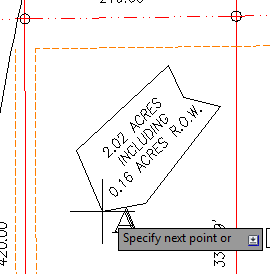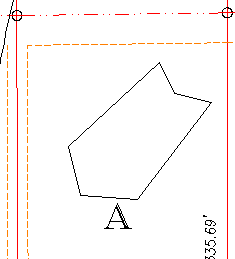Sometimes you need to hide your dirty laundry. The WIPEOUT command lets you do just that. You can create a polygonal outline that is filled with the drawing area’s background color. Everything behind the wipeout is covered up.
Also check out our other blog discussing CLIP and WIPEOUT function in detail.
You might cover up part of your drawing that represents unapproved designs, confidential data, or anything else.
You can find the command on the Home tab in the expanded Draw panel. It’s also on the Annotate tab in the Markup panel. Here are the prompts:
Specify first point or [Frames/Polyline] <Polyline>:
Specify next point:
Specify next point or [Undo]:
Specify next point or [Close/Undo]:
If you specify a point, you are prompted for more points so that you can create a custom shape, as you see here.

Here is the result when you press Enter to end the command.

If you have a polyline surrounding the area you want to cover up, you can choose the Polyline option. Then you see the following prompts:
Select a closed polyline:
Erase polyline? [Yes/No] <No>:
Use the Erase polyline? prompt to specify whether or not to keep the original polyline.
At the first prompt, there’s a Frames option. The frame is the border that you see surrounding the wipeout. When you choose this option, you have 3 subuptions:
- ON
- OFF
- Display but not plot
When you turn off frames, the wipeout seems to disappear, especially if no objects are partially covered by the wipeout, because it matches the drawing area background.
How do you use wipeouts?
Want more productivity tips like this? You can draw and edit faster and easier with this easy to follow top 25 productivity tips every AutoCAD user should know.
- Combine or subtract 2D shapes to create custom shapes - February 17, 2022
- Working with linetype scales - January 18, 2022
- Rename named objects–blocks, dimension styles, layers, and more - December 21, 2021

 Instagram
Instagram LinkedIn
LinkedIn Facebook
Facebook 
Good tip.
But please be carefull with the color of that wipeout. It must be RGB: 255, 255, 255 not any indexcolor.
Regards Jürgen.
I use wipeouts a lot, specially in blocks. Makes placing blocks over drawing-elements much easier, like doors and windows over walls, or furniture or sanitairy fixtures over hatched surfaces. Replacing these blocks is also verys easy without complicated stretching or completely redoing hatches.
I think many people will be happy with your tip on wipeouts, most people don’t know they exist.
We have run into plotting issues using wipeouts in the past so we try to avoid them.
I try using wipeouts again every once in a while. Initially everything is great, but sooner or later they all end up with DRAWORDER problems, wherein they stop working and I have to reassign a DRAWORDER “To Front” to the wipeout to make it work (or perhaps I assign “To Back” to the items I want hidden; I don’t remember.
It’s always so unpredictable that I go back to exploding and trimming, as much as I hate to do so.
Incidentally, Lou, there used to be major plotting problems with wipeouts back around R14 I think, but that’s been vastly improved.
When I print out the drawing in PDF program,
only the ‘wipeout’ area fill up as a black.
Is this problem in setting of plot/print?
But when I print out in Autocad(LT 2007),the drawing does not have like that problem.
I have to share my drawing with non CAD users
using PDF files in my company.
Please help me to find the solution.
In the past I used the whipeout function a lot, but older plotters/printers and some pdf creators like cutepdf don’t like it and give either a black or a black and white striped surface.
It’s not a fancy solution, but a solid hatch put in a layer called -wipeout or $wipeout with a color set tot 255/255/255 thats set to white in your *.ctb will fix that.
Another advantage with the use of a solid hatch 255 over wipeouts is the use of curved edges.
drawing order problems are terrible in autocad, that’s why i use wipeouts only in blocks, where the drawing order is fixed. If i want elements not to be seen i find it easier to place them on a separate layer that i can turn off, that’s what layers are for. DirkM’s tip is also usefull, but you might encounter drawing order problems in that way too.
For me it is: use wipeouts only in blocks and nowhere else.
Printing to pdf gives me no problems. I use autocad v 2011 en as a printer: dwg to pdf pc3.
hi,
I ve started using autocad 2013. Tried wipeout function , but for some reason it does not work. when I draw it above the object I want to hide, it does not hide it at all.Draw order does not help. Thats weird, because when I open the other drawings for example, with already existing working wipeouts . and try to draw new wipeout there then it works. and when I copy drawing wipeout from the new drawing where it does not work to the one where it works, suddenly wipeput function regains and the opposite if I copy from working wipeout file to not working wipeout file, then the copied one is not working as well. Probably some settings issue. It probably does not sound very clear. But if anybody knows , what setting shall I aply to make it working for future , it will be very appresciated. Thank you
Natalia,make sure wipeout is not on a no-print layer
Is there any command to hide out side the wipeout,(i want to work in the middle of a drawing and want to hide all drawing which is not in the wipeout boundry).
Thanks
Clipping can do that. See https://allaboutcad.com/how-to-control-what-you-see-by-clipping-xrefs-and-blocks/
I’ve tried to use wipeout in the past, but I’ve noticed a very big problem. If I try to dimension to the wipeout edge in paper space, the viewport scale is completely ignored, so the dimension is wrong. Has anyone else found this problem or got a solution?
Thank you, very helpful.
Your site is extremely helpful… thank you for all of your great info!
Hi remCAD,
As much as dimensioning in paper space is not a common practice, what I can recommend for you is to associate the viewport scale to your dimension.
DIMLFAC- used for nonassociative items such as paper space
by typing DIMLFAC in the command line, and setting its value to 1. you can use a scaled dimension in the paper space. Hope this helps